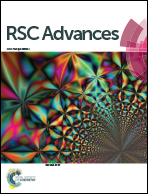Star-shaped magnetite@gold nanoparticles for protein magnetic separation and SERS detection†
Abstract
A novel synthetic methodology for star shaped gold-coated magnetic nanoparticles is reported. The coating is performed in two steps: formation of gold nuclei at the surface of magnetite nanoparticles followed by growth of the gold nuclei into a complete star shaped shell. The star-shaped gold-coated magnetic nanoparticles thus obtained preserve the magnetic properties of the precursor magnetite nanoparticles, e.g. they can be easily separated with a magnet. In addition, the gold coating provides interesting optical properties while simultaneously allowing for biofunctionalization that may be advantageous for biological applications, such as (bio)detection via surface-enhanced Raman spectroscopy (SERS). As a proof-of-concept, a capping agent terminated with a nickel(II)-nitrilotriacetate group showing high affinity for histidine was used to modify the surface of the nanoparticles. The resulting star-shaped nanoparticles were used to selectively capture histidine-tagged maltose-binding protein from a crude cell extract. Finally, the performance of star shaped gold-coated magnetic nanoparticles as SERS platforms was demonstrated through the detection of Raman active dye (Astra Blue).


 Please wait while we load your content...
Please wait while we load your content...